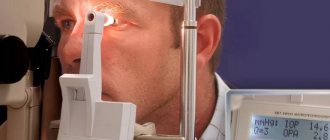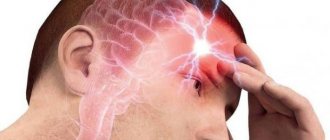“Intracranial pressure” is not a diagnosis, but a symptom!
But it, this very INTRACRANIAL PRESSURE, has entered our vocabulary so tightly that we sometimes even stopped thinking about what it is... Therefore (for ease of perception) we decided to put it in a separate section of diseases. You hear from your mother: “We came to treat intracranial, we have intracranial.” But in fact, you and I have it too. We are talking about increased intracranial pressure. So what is it? Attention! Let's get to the most interesting part.
Causes of intracranial pressure
Taking into account the fact that intracranial pressure is formed by the influx of cerebrospinal fluid (CSF) into the ventricles of the brain (special cavities where this substance is located), any violations of this indicator are in one way or another connected precisely with the redistribution of this fluid and nothing else. In turn, there are many reasons contributing to the disruption of the outflow or inflow of cerebrospinal fluid:
- Disturbance of metabolic processes when cerebrospinal fluid is not absorbed into the blood;
- Spasm of the muscular wall of blood vessels, preventing normal vascular circulation;
- An increase in the volume of circulating blood, which leads to an increase in the amount of cerebrospinal fluid;
- Insufficient oxygen supply to the brain;
- Meningitis;
- Hemorrhagic cerebral infarction;
- Inflammatory processes occurring in the central nervous system;
- Neoplasms of various types;
- Intoxication;
- Migraine.
Who is at risk?
The most common cause of increased intracranial pressure is considered to be traumatic brain injury. At risk are people for whom the risk of such injuries is increased (for example, due to professional activities or playing contact sports). Also, the likelihood of developing intracranial hypertension is higher for people with high blood pressure and the risk of ischemic stroke.
For children in the first year of life, the risk of high intracranial pressure is associated with hydrocephalus - water on the brain. It can be congenital and caused by disturbances during intrauterine development or acquired, resulting from birth trauma or infection.
Symptoms and treatment
Symptoms of intracranial pressure
Change in pupil reaction;- Swelling of the optic nerve;
- Problems with vision (peripheral vision is impaired first, and then central vision). Acuity decreases, diplopia occurs;
- Reduced hearing threshold;
- Dyspeptic syndrome consisting of nausea and vomiting;
- Severe headache that lasts for a long period of time, a feeling of constant fatigue and drowsiness;
- Pain when turning the head, as well as when sneezing and coughing;
- Sudden hyperhidrosis (production of a large amount of sweat), a sharp decrease in blood pressure;
- Irritability, nervousness, decreased ability to work;
- The occurrence of hematomas in the periorbital area;
- Pain in the cervical vertebra and spinal cord;
How to treat increased intracranial pressure?
It is necessary to understand that the condition in question is not an independent nosological unit, but a symptom of some disease that affects the human nervous system. Only after the pathology, the presence of which leads to an increase in intracranial pressure, has been identified, will it be possible to draw any conclusions. After all, it is reliably known that treatment of intracranial pressure (increased), equally as treatment of any other somatic pathology, can only be effective if its root cause is determined for the purpose of further elimination, and nothing else.
It is in order to correctly identify the root cause of the pathology that it is necessary not only to conduct a number of laboratory and instrumental studies, but also to consult a competent specialist who can interpret the results obtained, compare them with indicators of the objective condition, and then draw appropriate conclusions and select the correct treatment that will will relieve the symptoms discussed above.
If you notice signs of increased intracranial pressure, do not delay your visit to the doctor, this will need to be done as soon as possible, since what matters here is when exactly the necessary treatment will be prescribed.
The most experienced and competent neurologist in Tushino conducts an appointment in our clinic. Hurry up to sign up, because if treatment is started on time, it will be much easier to get rid of the pathological condition before the disease manifests itself and does not lead to undesirable consequences.
Get advice on visiting a neurologist. Consultation on the service does not oblige you to anything.
Who should I contact?
The first step in carrying out the procedure is to find out which doctor checks intracranial pressure in adults, since not every doctor has the necessary experience. Therefore, for diagnosis, you should make an appointment with a neurologist, since, according to medical rules, only he can carry out such a procedure. Often, neurologists themselves prescribe a diagnosis of intracranial pressure for preventive purposes, especially in situations where the patient is at risk of increasing it due to the disease or has certain symptoms.
Before checking intracranial pressure, the doctor must collect all the history he needs, and also evaluate the dynamics of the complaints that the patient previously indicated. Together with the subsequent examination, the doctor may additionally prescribe a number of examinations in order to get a complete picture of the situation.
Electroencephalography
Another way to check intracranial pressure is the electroencephalography procedure. In terms of the method of conducting it, it is quite similar to electrocardiography, but in it, electrodes are applied directly to the area of the patient’s skull, after which the device registers the biopotential of the brain. The doctor, looking at the results obtained, can use certain measurements obtained from the electrical activity of the brain to determine whether there are indeed abnormalities indicating an increased level of intracranial pressure. Such deviations usually include the presence of high-frequency rhythms, diffuse changes and excitation of brain structures in a chaotic manner.
External methods of stabilizing ICP
In alternative medicine, there is a wide list of effective external methods that can provide first aid for intracranial hypertension:
- Bath with linden. It is necessary to take baths with linden decoction in a sitting position, so for preparation you need to take 4 cups of dried raw material per 10 liters of hot water.
- Rubbing the ears with cool water. The procedure is repeated many times until you feel better.
- Foot bath with mustard. Place 2 mustard plasters in hot water, lower your feet and soak for 15-20 minutes.
To stabilize the condition, craniosacral therapy is used, which consists of influencing certain points located in the temporal and occipital regions. Due to the gentle effect on the skull, ICP decreases and well-being improves.
High intracranial pressure is a dangerous condition, as it can lead to the development of emergency complications, including death. To stabilize it, there are a large number of medications and folk remedies that can eliminate the manifestations of pathology, but they do not affect the main etiological factor. Therefore, if signs of the disease occur, it is necessary to visit a specialist for diagnosis and further selection of the optimal treatment regimen.
Traditional methods of correction
What should patients do to independently stabilize ICP? You can lower the level of cranial pressure at home using folk recipes. It is recommended to use herbs and plants that have sedative and vasodilating properties. However, non-traditional treatment is used for chronic intracranial hypertension in remission.
The following non-traditional remedies will help reduce intracranial pressure:
- Lavender infusion. 1 tbsp. l. place dry raw materials in a container and pour 500 ml of boiling water. Leave for an hour, then remove the sediment. Take 3 times a day, 1 tbsp. l. Therapeutic course - 3 weeks.
- Decoction of bay leaves. To prepare, you need to prepare several leaves, which are filled with 1.5 liters of water. Bring the mixture to a boil and use as inhalation. Course - 14 days.
- Clover tincture. Dried flowers of the plant should be taken in an amount equal to 0.5 liters of container. Fill with alcohol so that the liquid covers the dry raw materials. Leave for 2 weeks, then filter, take the tincture 3 times a day, 1 tsp. The duration of the course is 30 days.
Birch sap has a diuretic effect, due to which it normalizes ICP parameters
Treats intracranial hypertension with a mixture based on honey:
- To prepare, take 150 ml of fresh lemon juice, 350 g. liquid flower honey and 2 cloves of chopped garlic.
- Mix the ingredients thoroughly.
- Leave the mixture in a dark, cool place for 10 days.
- Take in the morning, in the evening 60 minutes after a meal at a dose of 1 tsp.
To quickly eliminate headaches accompanying a hypertensive attack, use lavender essential oil. A few drops of the product should be applied to the temporal area and rubbed in with light massage movements for several minutes.
What components influence ICP?
Among the main ones it is worth noting the following:
- cerebral vascular tone;
- cerebral perfusion pressure;
- volume of blood flow in the brain;
- function of production and absorption of cerebrospinal fluid into the blood;
- permeability of the physical barrier between the central nervous system and the circulatory system;
- the functioning of colloidal substances that exert pressure on the cerebrospinal fluid.
Changes in one or more of these systems can cause a decrease or increase in the level of cerebrospinal fluid in the cranial cavity.
Examination by an ophthalmologist
For a more detailed study of how to measure intracranial pressure, we will consider each of the above methods separately. Let's start with an ophthalmological examination of the patient to measure intraocular pressure. To carry out the procedure, the doctor must take a special slit lamp, which helps to recognize the main symptoms of this pathology.
Typically, an ophthalmologist can talk about an increased level of ICP based on two main signs: papilledema and dilated vessels in the retina. If these symptoms have been identified, the ophthalmologist takes a Maklakov tonometer, which is specially designed to measure intraocular pressure, and then measures it. If this pressure is increased, then this is a significant sign that the patient also has increased intracranial pressure.
Verification methods
Listed below are ways to measure intracranial pressure in adults. This procedure is complex, so the patient will have to undergo several types of examinations and consultations with specialists. Prescribed procedures may be:
- Measurement of intraocular pressure carried out by ophthalmologists through examination.
- Using electroencephalography, a person's brain activity is assessed.
- Neuroimaging, performed using computed tomography and magnetic resonance imaging, checks the normal state of the cerebral ventricles.
- Spinal function is the best way to check intracranial pressure, since the cerebrospinal fluid can be examined in detail under a microscope.
- For newborns and infants, intracranial pressure is measured using ultrasonography, that is, the brain is examined using conventional ultrasound.
Puncture
The best way to check intracranial pressure is to perform a spinal tap. This procedure is also good because it will not only show the current level of pressure, but will also tell the most obvious reason why it has risen. Diagnosis must be carried out in a treatment room in compliance with a certain number of rules.
To diagnose, the doctor inserts a puncture needle, to which a pressure gauge is connected, which allows you to find out the level of intracranial pressure from the flowing cerebrospinal fluid. However, even without a pressure gauge, the doctor can often tell whether it is within the normal range. In cases where cerebrospinal fluid flows out in frequent drops or even in a real stream, this indicates an increased level of ICP, and if only rare drops appear, then the pressure is within normal limits.
Therefore, the most common answer to the question of which device is used to check intracranial pressure is a pressure gauge. In cases where the water column remains between 80 and 170, we can say that the pressure is normal.
Gymnastic exercises
Therapeutic exercises for intracranial hypertension can become an alternative to certain drugs during conservative therapy, as well as a prophylactic agent to reduce attacks of the disease. Depending on the cause and stage of the pathological process, the specialist selects techniques that have lowering properties of brain pressure and alleviate the condition of patients.
A specially developed set of gymnastic exercises is aimed at normalizing ICP, relieving pain and increasing blood circulation.
The most effective exercises to reduce high cerebral pressure:
- We alternately tilt our heads to the right and left sides, forward, backward, pulling the chin to the chest. Next, we slowly rotate the head in any direction. Movements should be smooth, the number of repetitions of exercise elements should be an average of 20 times.
- Grasp the lower occipital region with both hands so that the thumbs are located on the neck muscles, at the level of the earlobe. Then, for 15 minutes, fingers should be rubbed over the muscles from top to bottom to improve the outflow of cerebrospinal fluid. After the exercise, heaviness in the temporal and occipital areas decreases.
- Grasp a small round stick with both hands and place it behind your head. For 15 minutes, with light pressure, we move the stick over the neck muscles and lower occipital region.
Important! In the first days of the gymnastics course, painful sensations may occur due to tension in the neck muscles, but subsequently, when performing the exercises, the discomfort will disappear.
How to identify the problem yourself?
It is impossible to determine the level of cerebral pressure at home, since this procedure requires special equipment. Normal values for an adult are 100-150 mm. rt. Art., if they increase, then the person experiences negative symptoms. You can independently identify intracranial hypertension using the following signs:
- regular headaches;
- nausea, vomiting not associated with food intake;
- causeless weakness, fatigue;
- memory loss;
- attention disorder;
- an attack of dizziness is accompanied by fainting;
- decreased peripheral visual acuity;
- sharp fluctuations in blood pressure;
- weak pulse.
The headache is long-lasting and constant, worsening at night and after waking up
The main manifestation of the pathology is intense headaches that are not amenable to medication. The pain syndrome is bursting in nature and is localized in the frontal, occipital, and temporal regions.









